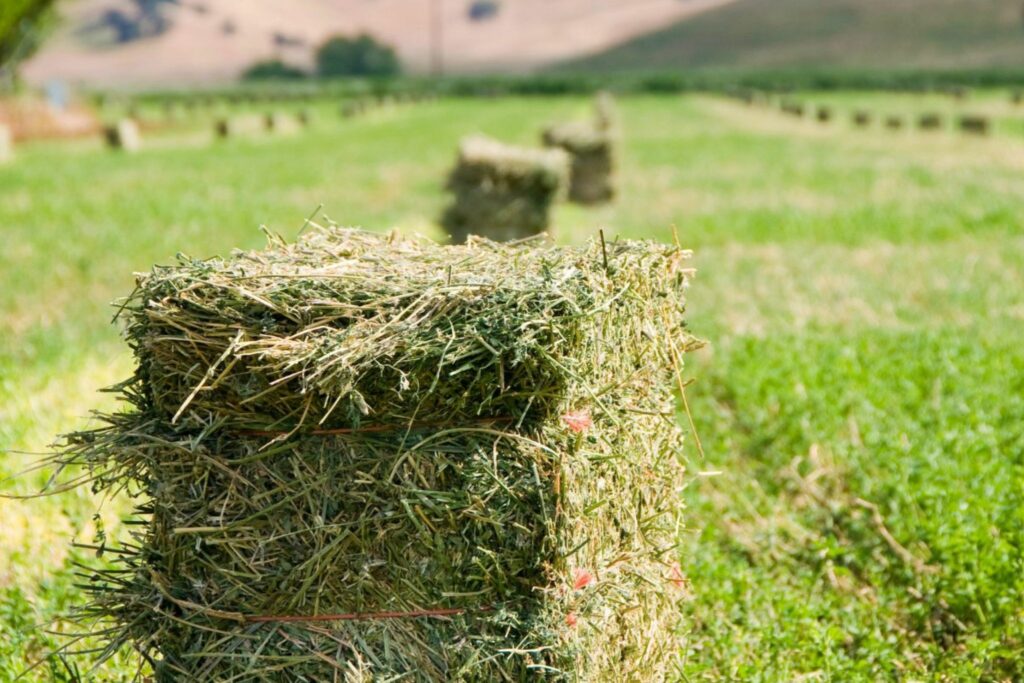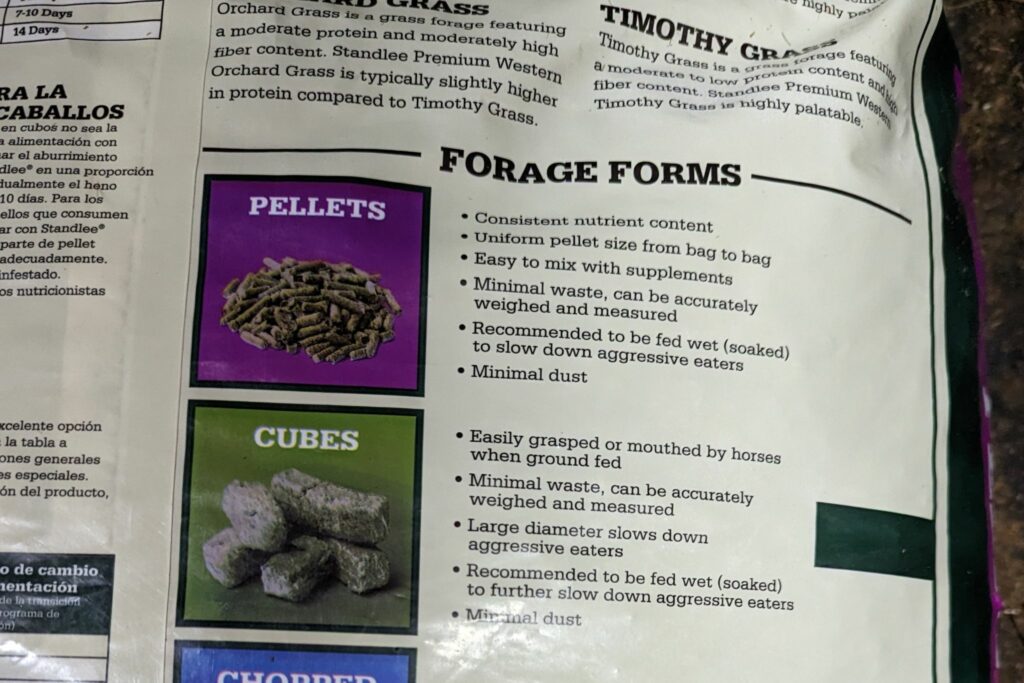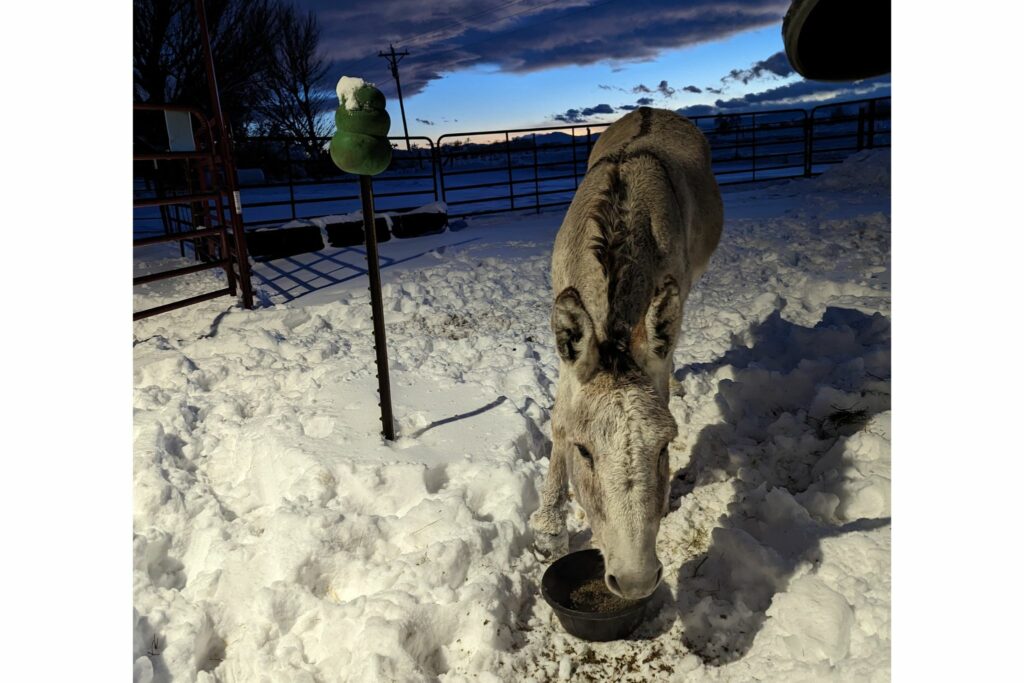Horse News
Member
Processed Hay: Friend or Foe?
When pastures go brown in the winter, or you have a horse who needs some extra calories, consider supplementing with alfalfa. Aside from its availability in bale form, you can also buy alfalfa processed into cubes or pellets, which prolongs its shelf life while providing a different feed format.
We’ll dive into the features and benefits of these two great forage alternatives so you can better understand if they might be right for your horse.
Horses need to eat about 2% of their body weight each day in forage. Alfalfa cubes and pellets can be a great way to help reach that total. Flakes of hay shouldn’t be eliminated completely, as they provide the long-stem fiber horses need for healthy digestion.
Always soak cubes and pellets before feeding to prevent choke!
As with all horse feed, be sure to measure by weight (dry weight) and not volume to ensure you’re feeding the right amount. Also, chat with your veterinarian before making changes to your horse’s diet.
Forage Requirements for Horses
Horses need a minimum of 2% of their body weight in forage a day. For a 1,000-pound horse, this equates to at least twenty pounds of hay per day.
Horses in work may need additional calories, whether that be more hay or grain supplementation.

source: canva
Digestive Function
Forage is key to a healthy digestive system. The equine digestive tracts contain billions of protozoa and bacteria specifically designed to digest plant fibers (like the kind found in grass and hay).
Horses were designed to eat almost continually throughout the day, with forage breaking down slowly as it travels along the intestines.
What is long-stem fiber?
Horses need long-stem fiber to keep their digestive system working properly. Long-stem fiber is defined as hay or grass pasture that is 2” in length or longer.
For this reason, feeding a complete ration (pellets only) or only offering hay in pelleted or cubed form is not ideal.
Processed Hay for Horses
When grass or flakes of hay either isn’t an option or isn’t enough, you can supplement your horse’s diet with processed hay like cubes or pellets.
For horses who have poor dentition, soaked cubes or pellets may be their only source of forage.

source: Bottomless Backpacks
Hay Cubes
Hay cubes are made by cutting dried hay down into smaller pieces (usually one to two inches in length), mixing it with water and bentonite (a natural binder), then using pressure to form a cube.
They are then dried to allow for storage.

Click to see alfalfa cubes at Amazon

Hay pellets are made by grinding dried hay into a powder. The powder is then conditioned with steam and pressed into pellets using a specialized machine.
Finally, the pellets are cooled and packaged.

Click to see alfalfa pellets at Amazon
 How to Feed Hay Cubes and Pellets to Horses
How to Feed Hay Cubes and Pellets to Horses

Hay cubes and pellets work best as supplements to feeding hay flakes. You can substitute cubes and pellets with flakes of hay, pound-for-pound.
If you have a senior horse with poor (or no) teeth getting hay pellets instead of flakes of hay, they’ll need 15 to 25 pounds of pellets per day to maintain their weight.
When using cubes or pellets to help with weight gain, don’t substitute processed hay for flakes—add it! A few extra pounds of alfalfa per day can do wonders in improving a horse’s body condition score.
If flakes of hay are hard to come by, you can replace them on a 1-1 ratio for maintenance. Make sure you introduce both pellets and cubes to your horse’s diet slowly. At least half of a horse’s daily forage needs should be met with hay flakes (meaning you could feed ten pounds of hay flakes and ten pounds of cubes).
Regardless of the Form…Soak It!
Feeding dry pellets or cubes has a high risk of choke, so it’s important to always soak them first. Choke in horses is defined as when food (or a foreign body) blocks the esophagus.
Choke isn’t quite as big an emergency as with people (the horse can still breathe), but it is something to take seriously and avoid if at all possible.
Soaking cubes or pellets is also a great way to make sure your horse is getting enough water, especially in the winter! Depending on the product and the water temperature, you may need to soak anywhere from ten minutes to two hours prior to feeding.
For example, during the winter months, you can use boiling water to make a hot mash at night. 1 pound of alfalfa pellets only takes about ten minutes to break down.
You can also soak cubes overnight.

source: Bottomless Backpacks
Feed by Weight, Not by Volume
It’s important to feed cubes and pellets by weight, not by volume. Adding water increases the volume but doesn’t add any nutritional value.
Do you weigh alfalfa cubes wet or dry?
Always weigh alfalfa cubes dry, then soak them before feeding. This ensures your horse gets the right amount of forage every day.
How many alfalfa cubes equal a flake?
This depends on the flake and the cubes. Let’s assume a five-pound flake and a forty-pound bag of cubes. You’d have to feed one-eighth of the bag to equal one, five-pound flake.
Processed Hay Benefits
Cubes and pellets are easy to transport and bring to places like shows. They’re also easier to store and don’t leave as much mess as flakes of hay.
These products are great for senior horses.
Any horse that needs to gain weight (or put on muscle!) could benefit from either.
Processed Hay Drawbacks
Pellets can’t replace flakes completely since they aren’t long-stemmed. Cubes can be substituted at a higher level, but still shouldn’t replace hay completely.
Feeding only alfalfa pellets could potentially cause colic because they aren’t long-stem forage. For an easy keeper, feeding these products could cause horses to become overweight.
Both issues can be managed by keeping a close eye on portion size and calculating the correct amount to feed, while also taking into account exercise.
Frequently Asked Questions
Q: Are alfalfa cubes as good as alfalfa hay?
In some ways, alfalfa cubes may be even better. Processing the cubes means the nutrient profile may be more consistent than what you could find in a bale of hay, especially across different cuttings.
Cubes, however, lack the long-stem fibers horses need for digestive health (most cubes are only one inch long, which is half of the length a horse needs).
Q: Should I feed my horse alfalfa cubes?
Alfalfa cubes are a great option for horses. Whether you need an alternate source of forage for a healthy horse, a way to help a horse gain weight, or are looking for a special treat, most horses love eating soaked alfalfa cubes.
Q: Are alfalfa cubes or pellets better?
Nutritionally speaking, alfalfa cubes and alfalfa pellets are the same. The choice comes down to which one your horse prefers to eat (or you prefer to feed). Check out this video for more info on feeding cubes and pellets.
Q: Will alfalfa cubes put weight on a horse?
Alfalfa is higher in protein and calories than other hays, which makes it a great way to help your horse gain weight. You can also add a bit of oil to the soaked cubes for some extra fat.
Q: Can you feed alfalfa pellets instead of grain?
Alfalfa pellets can’t replace grain completely, which offers a range of vitamins, minerals, and even prebiotics your horse needs for optimal digestion.
If your horse gets fat on air but you’re still looking for something to feed them (or need something to serve with his supplements), you can do a mixture of soaked pellets and a ration balancer.
Q: How much does 1 cup of alfalfa pellets weigh?
This can vary slightly based on brand, but on average, one cup of dry alfalfa pellets will weigh four ounces.
Parting Thoughts
Both alfalfa cubes and pellets can be a nutritious forage addition to your horse’s diet. Just remember to soak!
P.S. Enjoy this article? Trot on over to:
- How to Soak Hay for Horses (And Why Bother!)
- Winter Hay 101: How Much to Feed Your Horse (And Why)
- 30+ Equine Nutrition Terms Your Horse Wishes You Knew
- Can horses puke? You might be surprised.
- A Pinch or a Pound? How to Feed Loose Salt to Horses
- Stability & Safety: How to Stack and Store Hay Bales
- Best Feed for an OTTB: An Art and a Science
- A Beginner’s Guide to Horse Hay Nets and Bags
- 3 Types of Horse Feed Every Owner Should Understand
- Tips & Tricks: How to Help Senior Horses Gain Weight
- Winter Hay Quiz
The post Alfalfa Cubes vs. Pellets: What’s Best for Your Horse? appeared first on Horse Rookie.
Continue reading...
